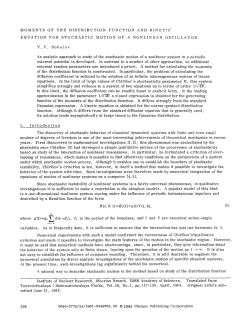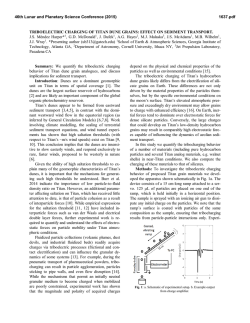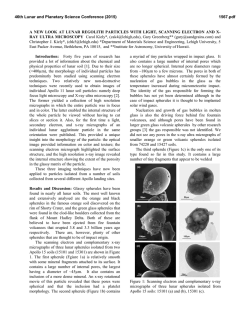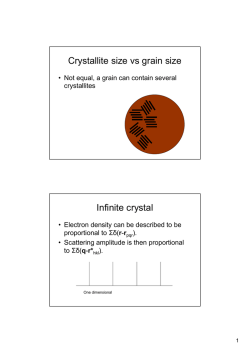
Polyelectrolytes between two membranes or colloidal particles
J. Phys. A: Math. Gen. 21 (1988) 2739-2751. Printed in the U K
Polyelectrolytes between two membranes or colloidal particles
J H J van Opheusden
Center for Theoretical Physics, University of Twente, POB 217, 7500 AE Enschede, The
Netherlands
Received 9 October 1987, in final form 1 February 1988
Abstract. We investigate the equilibrium behaviour of charged polymers of finite length
in a Debye-screened potential between two parallel charged walls. For the polymer we
take the continuum approximation to calculate the spectrum of eigenfunctions for the
partition function. For finite but long polymers only the lowest two terms in this expansion
contribute to first order to the configurational sum, corresponding to a symmetrical and
an antisymmetrical solution. Within this formalism we calculate the monomer density
distribution for finite strands of polymer attached to one or both surfaces (tails, loops and
bridges) as well as for polymers free in solution. For the free polymer we also find the
free energy as a function of the distance between the plates for several values of the
interaction parameters, as well as the effective interaction between the plates due to the
polyions. This shows that there can exist an equilibrium separation distance between
colloidal particles due to the interactions with charged polymers in solution. This mechanism may also explain the formation of rouleaux for red blood cells.
1. Introduction
In this paper we will discuss the equilibrium density distribution of polyelectrolytes
near red blood cells or charged colloidal particles when two of these come close
together. As a simplified model we consider two parallel planes with, between the
plates, an ionic fluid containing in addition to the small salt ions a small amount of
polyelectrolyte. This can improve our understanding of the behaviour of polyelectrolytes in the small gap between two cells or colloidal particles when these are very
close. When the polymer binds to the wall of the particles it can form bridges across
the gap and thereby give rise to a very strong binding force between the particles. This
is one mechanism to explain the formation of so-called rouleaux of red blood cells
(Wiegel and Perelson 1981). For short-range interactions of the monomers with the
surface of the particles other types of models can be considered, like the lattice model
we have investigated earlier (van Opheusden er al 1985). In this model also a strong
binding can occur.
2. The Poisson-Boltzmann equation in one dimension
For the Debye screened electrostatic field of a charged colloidal particle or a red blood
cell very close to its surface it seems justified to consider a one-dimensional approximation. The surface is modelled as a single charged wall at x = 0, extending to infinity
in the y and z directions. In this particular case the full non-linear Poisson-Boltzmann
0305-4470/88/ 122739+ 13$02.50 @ 1988 IOP Publishing Ltd
2739
2740
J H J van Opheusden
equation can be solved (Lampert and Crandall 1980, Verwey and Overbeek 1948).
The difference between this solution and that of the linearised equations is that there
is somewhat stronger screening very close to the wall, while at larger distances the
effects of non-linearity diminish rapidly. In principle there is no problem in investigating the behaviour of the polyelectrolytes in the potential that is the solution of the
non-linear Poisson-Boltzmann equation. This term, when included in the equation
for the partition function of the polyions, only plays the role of an external potential
and the resulting equation remains completely linear. The only point is that the equation
cannot simply be transformed into one for which solutions can be expressed in terms
of elementary functions, as is the case for the formalism to be described next. One
would have to rely instead on a numerical solution of the equations under consideration.
One should note, moreover, that the screening effect is caused by the small ions, the
polyions themselves not influencing the potential field. We will hence neglect all
non-linear effects and consider the general solution of the linearised equation
V(X) = A exp(-kDX)
+ B eXp(kDX).
(1)
When the wall is held at a constant potential V, the bounded solution is
V(x) = v, exp(-k,x).
(2)
We want to calculate the field in the gap between two colloidal particles. Therefore
we introduce a second wall, which is parallel to the first, and at a distance 6 such that
the potential V, is effectively screened, i.e. 6 >> k;'. Raising the potential on the second
wall to V, will then result in a redistribution of the ions that gives the same screening
effect. The potential between two walls prepared in this way, located at positions x = d
and x = -d is given by
V(x) = v,
Cosh( k&)
cosh( kDd)'
(3)
To illustrate the validity of this approximation consider two spheres of radius R,
far apart from each other, and each with a surface potential V,. The Debye screened
field of a single sphere at the orgin is
In terms of the distance S to the surface of the sphere, S = r - R, equation (4) becomes
V(R+S)= voexp(-k~S)R/(R+8).
(5)
Thus close to the surface the potential is approximated by that of the flat wall (equation
(2)), as could be expected. If two spheres are placed along the x axis, with their
surfaces at x = d and x = -d, respectively, the potential in the gap between the spheres
along the x axis becomes
v(X)=2vo eXp(-kDd) COSh(kDX)
( d << R )
(6)
which is essentially the same solution as equation (3). This solution follows from a
simple superposition of the potentials from both walls, which is allowed in the linearised
theory. Note that we have assumed that the charge distribution on the colloidal particle
itself does not change because of the other particle.
Polyelectrolytes between two membranes
2741
3. Small concentration of polyelectrolytes
When a small number of polyelectrolyte chain molecules, with charge opposite to the
colloidal particles, is added to the solution these chains will tend to adhere to the
particles because of the attractive potential, while on the other hand the heat motion
tends to move the chains away from the surface. In this section we calculate the
partition function of a single, long but finite chain between two colloidal charged
particles. For the adsorption to a single colloidal particle a continuous model has
been used by Wiegel (1977). We will consider the effect of a second particle within
this model.
We assume that the amount of polyelectrolyte is so small that it will not affect the
charge distribution in the solution. Because we consider this low-density limit we may
also ignore excluded volume effects between the polymers. The potential between the
spheres is taken to be as given in equation (3). For chains of length N the partition
function G ( r o , I N , N ) in the gap between the particles is the solution of the diffusionlike equation (Wiegel 1975, Freed 1972)
[a/aN-al1 2 V 2 +PV(r)]G(ro, r N , N ) = 0 .
(7)
Here ro and rN are the positions of the particles at the two ends of the chain and 1 is
the length of one monomeric unit. Note again that the potential is not influenced by
the charges on the polyelectrolytes themselves but only by the small counterions in
solution. In particular, this implies that there is no extra swelling of the polyions,
other than possibly a somewhat larger effective Kuhn length 1. For the dilute solution
of polyelectrolytes we neglect the small non-linearities this would produce in (7), which
would otherwise have to be solved in a self-consistent fashion. For the parallel-plate
geometry, equation (7) separates in Euclidean coordinates. The solution is a formal
for the x coordinates, and normalised
expansion in terms of eigenfunctions
Gaussians n ( 5 ) in the y and z directions
+,
c
CO
G ( ~ or , ~ N, ) = ~
( Y N
-YO)~(ZN
- ZO) +,(xN)+~(xo)exp(-A,N)
0
(8a)
where
n ( 5 )= ( ~ T ( T ) - ” exp(-t2/a2).
~
The
+,
(8b)
are the solutions of
We must solve this equation in order to find the spectrum
using expression (3) for the potential V(x).
+,
with corresponding A,,
4. Debye screened potential between two walls
The problem of the adsorption of polyelectrolyte to a single wall with a Debye screened
potential has been solved before (Wiegel 1977). For the single wall the potential is of
the form (2)
V(x) = - V, exp(-k,x)
(10)
2742
J H J van Opheusden
where we have introduced the extra minus sign to have an attractive potential, while
the parameter Vo remains positive. It was shown by Wiegel (1977) that a bound state
exists provided
24p VQ/k&12>j;,,
(11)
with j , , = 2.4048 . . . the first real zero of the Bessel function Jo. This solution can be
found by considering equation (9) with the potential as given in (10) and making the
substitution
S(X)
= (24pVo/ kL12)-1’2eXp(-$kDX)
So
eXp(-$kDX).
(12)
One then finds the Bessel equation
)0
(s2d2/ds2+ sd/ds + s2+ A n ) f n ( s=
(13)
A,, = 24h,pVQ/k&12.
(14)
with
As boundary conditions we take +(O) = 0 and +(L) = 0 for some finite value of L, and
consider the limiting solution as L + CO. If we now take the potential of both walls,
equation (3), but with x shifted over L, such that the first wall lies at x = 0 and the
second at x = 2L, we have
For kD<<L, i.e. when the Debye screening length is small compared to the gap width,
some simplifications are possible. The prefactor in this case is nearly equal to Vo, and
the substitution (12) leads to an equation similar to equation (13):
[s’ d2/ds2+ sd/ds
+ s 2 + SA eXp(-2k&)/S2+
An]fn(S)
= 0.
(16)
For x < L the extra term can be considered to be a small perturbation, so we may use
the solutions of the single-wall problem, though one must be careful with the boundary
conditions. For the single wall the boundary condition at x = L is f ( s L )= 0, because
one wants the solution to vanish when L + CO. Here we have used the shorthand notation
sL=s0exp(-k,L).
(17)
The effect of the second wall is that the potential for x > L is exactly the mirror image
of that for x < L. Hence the solutions of the eigenfunction equation will also have
this symmetry, but there may be a parity change. In other words, next to the antisymmetric solutions, which have a nodal point at x = L, there exist symmetric solutions.
In both cases the boundary condition at the impenetrable wall is a vanishing partition
function, so we have
L(S0) = 0
(df,/ds)s=sL= 0
(18a)
for the symmetric solutions and
fa(S0)
=0
fa(sL)
=0
(186)
for the antisymmetric solutions. The general solution of the unperturbed equation is
f(s) = C,J”(s)
+ C2J-,(s)
(19)
Polyelectrolytes between two membranes
2743
with A, = - v 2 , and J,, the Bessel function of order v. Substitution of the general
solution into the boundary equation for the antisymmetric solution gives the equation
J , ( s o ) / J - (so) = Jv (sL)/’J-~ ( s L ) .
(20)
In the limit L + CO,that of the single wall, the right-hand side of this equation vanishes
because sL+ 0 and thus J v ( s L )+ 0 for positive v. The boundary conditions for the
symmetric solutions yield the relation
As is to be expected for the case sL+O both equations become equivalent. Strictly
speaking the general solution is not valid at integer values of v, where J , and J - , are
linearly dependent and other types of Bessel functions should be used. The distinction
is not really important for the generic case of non-integer v. As stated for the single
wall, the right-hand side vanishes and bound-state solutions exist only when so >j 0 , ] ,
the first zero of J o . For any positive v the first zero is increasing monotonically with
v (Jahnke et a1 1966).
Of course one can solve equations (20) and (21) numerically. However, as we
consider the case in which the two walls are not too close, we can do better. At least
for the lowest bound state, when so is between j 0 , ]and j0,*= 5.135 62 . . . , we know that
sL is also small. Hence we may use the asymptotic formula for the Bessel function
with small argument (Abramowitz and Stegun 1965)
~ , ( ~ ~ ) = ( ( t.).~ ~ ) ~ / r ( i +
(22)
Substituting this in (20) and (21), and using expression (17) for sL, one obtains
with the plus sign for the antisymmetric solutions and the minus sign for the symmetric
ones. In the limit L + 00 the single solution is v = vo and for large but finite L this
level splits up into a doublet at v, = vof A V with
The splitting is important because it gives an indication about the relative importance
of the antisymmetric solution in the eigenfunction expansion (8), as the eigenvalues
are still given by A = - v 2 for both types. The relative weight of the antisymmetric
solution for a polymer of length N is approximately exp(-4NvoAv). In the limit of
very long chains, N >> 1 , the partition function is dominated by the lowest eigenvalue
A, = - v i . For the double well we have to be a bit more careful. The lowest eigenvalue
always corresponds to a symmetric solution, but the lowest antisymmetric solution has
an eigenvalue relatively close to this one. Consequently, for quite large N, regardless
of the symmetry of the problem itself, the solutions can be quite asymmetric, corresponding to a considerably higher concentration of polymer in one of the wells as
compared to the other.
2744
J H J van Opheusden
5. Monomer density between two walls
By solving (20) and (21) we obtain the ground state and the first excited state of (13),
with boundary conditions as given by (18a) and (18b). For the case of a long but
finite polyelectrolyte these two solutions give the lowest two terms in the eigenfunction
expansion for the partition function. We may neglect higher-order terms in this
expansion because the corresponding eigenvalues A, are separated from the lowest
two by a relatively large energy gap. For infinite chain length the parition function is
completely dominated by the ground-state solution.
In order to determine the density of polymer material at a certain point x between
the walls one has to consider all possible configurations of a polyelectrolyte chain
which pass through this point. The number of configurations with endpoints at xo and
xN, and the nth monomer held fixed at point x, is proportional to the three-point
function G3(x0,x, xN, n, N ) . As we consider a chain of the Markov type, without
excluded volume effects, we can take this single chain to consist of two shorter chains,
or two tails fixed together at position x. Both tails assume configurations according
to the partition function of a polyelectrolyte of that specific length. Hence the density
for all monomers becomes
with C a normalisation constant such that
d x p ( x ) = 1.
Because we have a linear theory any overall constant can be used as a normalisation
for the density function.
It is assumed implicitly in this equation that the endpoints of the polymer can
move freely through the potential field within the gap, and all possible end positions
have to be considered. For polymers attached to the surface with one end, the
integration over xo in equation (25) is not appropriate, but instead one should consider
the limiting behaviour when the endpoint approaches the surface. In this case
An analogous expression holds for polymer loops, which are bound on both ends.
Strictly speaking, the approximation of G by taking only the lower states is valid
only for large polymer length, i.e. when the monomer considered is far from both ends.
For long polymer chains the end effects are not very important, and one can use only
the lowest, or two lowest terms, in the series expansion for the partition function
where the &(x) are orthonormal eigenfunctions when written in the s language, with
a corresponding norm of the linear equation (13). In the case of ground-state dominance
all end effects become irrelevant and both (25) and (27) reduce to
P(X) = +&).
(29)
Polyelectrolytes between two membranes
2745
When there is no ground-state dominance matters become more complicated, even
if one only considers the effect of the first excited state. In this case we have the
ground-state doublet, formed by the symmetric solution $, and the antisymmetric
solution 4,, which has a slightly higher eigenvalue. The difference AA = A,- A, is small
compared to the difference between A, and the first excited symmetric state. The
partition function becomes
G(x1, ~ 2n,) = $s(x1)$s(x2)+ $a(xl)$a(xd e x ~ ( - n A A )
(30)
where an overall constant exp(-A,n) is neglected. When this is substituted in (25) the
summation over n can be performed, and the general result is, for large N and small
AA,
Here we have not explicitly written the x dependence of the functions i,bs and 4,. Once
these functions are known it is straightforward to perform the integrations in this
equation. In fact we do not need the functions explicitly, because the integral over
$, is always identically zero.
For the free polymer chain, equation (24) gives immediately
Pfree(X) = $%(x)
(32)
i.e. we get the same result as for ground-state dominance. For the polymer with both
ends free in this order there is no effect on the density distribution between the particles.
Higher-order terms in the eigenfunction expansion have to be included to find a
deviation from the ground-state behaviour for shorter polymers. When one or both
ends of the polymer are attached to the surface we have to be a little bit careful. As
the functions $s and 4, vanish at the surface we must consider the limiting behaviour
as described for (27). For a polymer chain with one end attached to one surface and
the other end attached to the other surface, forming a bridge between the particles,
we have $,(x0+ 6) = (Irs(xN- 6) = SE and $,(x,,+ 6 ) = -$,(xN - 6) = AE, for x,, = 0 and
x N = 2L, with E, 6 + 0. In other words we define S = +:(x0) and A = $g(xo). The density
distribution for a bridge becomes
hridge(x)
= [S2$I-A2$: exp(-NAA)]/[S2-A2 exp(-NAA)]
(33)
which does show some effect of the antisymmetric solution. Relative to the solution
for the finite chain with both ends free the density in the middle between the walls is
increased. This comes from the fact that for the free chain many configurations exist
in which the full chain is in one of the potential wells, and no monomer density in
the centre is generated. All these configurations are excluded for the bridge model.
Hence, by forcing the chain to cross from one wall to the other the relative abundance
of this type of configuration in the total configuration sum is enhanced, and the density
in the centre is increased.
When only one end is attached to a surface we have a polymer tail
Ptaii(X)= {WL:+ A$s$a[ 1 - exp( - N A A )I/ N AA }/ S
(34)
J H J van Opheusden
2746
and for both ends attached to the same surface, a polymer loop, we find
+ 2AS+,+J
1 - exp(-NAA)]/NAA}/[S’+
A’ exp( - N A A ) ] .
(35)
Note that the asymmetry for tails is approximately half the effect found for loops, as
can be expected when one end is free to cross over to the other surface. When one
considers the case in which there are polymer tails on both surfaces the asymmetry in
(34) cancels completely, and the result for ground-state dominance is recovered, at
least to this order. This is in accordance with the remark made above about the increase
in density for polymer bridges near the centre; for polymer tails no such effect should
be expected.
In figure 1 we plot the monomer density of bridges between the walls for a number
of different values of the polymer length. One observes that for decreasing N the
density in the centre between the particles or cells increases, while it decreases
accordingly near the walls. Because the symmetric solution
and the antisymmetric
solution that enter the equation for the monomer density of bridges (equation (33))
do not depend on the polymer length, all curves trivially pass through the point where
= Gs. In figure 2 have we plotted the density for tails, polyelectrolyte chains fixed
to the wall at x = 0. For increasing chain length one observes a decreasing asymmetry
of the monomer density between the walls. For the case of infinite chain length, as
pointed out, the density profiles of tails and bridges are, of course, identical.
In figures 3 and 4 one finds the monomer density of the infinite chain for various
values of the depth of the potential well, or rather the parameter so as defined in
equation (12), and the distance between the walls in reduced units kDL, respectively.
For decreasing values of so one observes an increase of the density in the centre between
+,
+,
+,
0
0.5
2.0
XlL
1.5
.O
Figure 1. Monomer density between colloidal particles or cells with a Debye screened
potential for bridges of various length. The polymers are fixed with one end to one particle,
at x = 0, while the other end is fixed to the surface at the other particle at x / L = 2. The
values of the parameters as used in the text are so = 3, k,L = 10 and the different lengths
are given by N = 10, 15, 20, 30 and cc,the limit of infinite chain length. One observes that
for longer chains the polymer material is more confined in the potential wells near the
wall, while the density in the centre is largest for short chains, giving rise to a fairly flat
concentration profile.
2747
Polyelectrolytes between two membranes
0
Y
0.5
1.0
1.5
0
xlf
Figure 2. Monomer density between colloidal particles or cells with a Debye screened
potential for tails of various length. The polymers are fixed with one end to the impenetrable
wall at x = 0, while the other end dangles free into solution. The values of the parameters
as used in the text are so = 3, k,L = 10 and the different lengths are given by N = 10, 20,
40,80 and CO. In the limit of infinite chain length all end effects disappear and there is no
distinction whatsoever between tails, bridges or free polymer chains. One observes that
for shorter chains the polymer material is more confined in the potential well near the left
wall to which the tails are attached, while for the long chains the concentration profile is
more symmetrical.
.Q
xlL
Figure 3. Monomer density between the walls in the limit of infinite chain length ( N = C O )
for various values of the depth of the potential well, or rather the parameter so, which is
a combination of several physical variables (equation (12)). The values are so = 2.5, 2.75,
3.0, 3.5 and 4.0 and the particle distance is fixed at k,L = 10. For small values of so the
monomer density in the centre is quite large. The flat profile is caused by the fact that,
for shallow wells, bridges, i.e. configurations with strands of polymer material crossing
from one well to the other, become more abundant. For larger values of so the monomers
are confined to the wells, with large strands in a single well, and only few bridges. Hence
the density in the centre drops, while the maximum of the concentration curve shifts
towards the walls.
2748
J H J van Opheusden
xlL
Figure 4. Monomer density between the walls in the limit of infinite chain length ( N = C O )
for various values of the distance between the cells or colloidal particles. The values as
used are k,L = 2, 5, 10, 15 and 20, while the value of so is fixed at so = 3. For small values
of k,L the monomer density in the centre is large. Because the particles are very close,
bridges are common. In fact, for the shortest distance k,L = 2, the effect of the electrostatic
attraction gives rise to only a very minor broadening of the density profile as compared
to that of an infinite polymer chain confined between two hard walls. For larger values
of k,L the monomers are concentrated near the walls and only an incidental bridge is
formed. The shift of the maximum of the concentration curve towards the walls is caused
mainly by the scaling, the value of k,L increases, but the width of the potential well
remains fixed at about x = l / k , L .
-0.5-
a
-1.0
- 1.5
- 2.0
Figure 5. The free energy per monomer as a function of the distance between the two
charged colloidal particles or biological cells for diff erent values of the adsorption parameter
so (so = 3.0, 3.5, 4,O).We show only the thermodynamic limit of infinite chain length as
the correction due to finite chain length is only very small. One observes a minimum of
the free energy corresponding to an equilibrium distance between the walls due to the
effect of the polyelectrolytes. This minimum shifts towards a smaller equilibrium separation
distance at larger values of so. The increasing depth of the effective potential gives rise to
a stronger binding between the particles or cells, and hence a more stable association.
Polyelectrolytes between two membranes
2749
the walls as the polymer chain starts to form an increasing number or bridges, i.e.
strands of polymer which cross from one potential well to the other. Also a shift of
the maximum of the curves away from the wall can be observed corresponding to a
shift of the maximum of the Bessel function for decreasing values of v,. For the lowest
value considered, so = 2.5, only slightly above the critical value of j , , (equation (1l ) ) ,
v, is almost zero, but positive, and a bound-state solution is found. The density between
the walls for this solution is almost completely constant. The same effects can be
observed for a decreasing distance between the walls. The shift of the concentration
maximum, however, is mainly due to the scaling of the abscissa of the figures, where
we have plotted x/kDL. Apart from this somewhat artificial effect there is also a real
shift in the value of vs, as in figure 3, but that is much too small to be observable (see
figure 5). For small particle separation the monomer density again becomes very flat,
because the bridges become more abundant.
6. Thermodynamic quantities
In order to find the thermodynamic quantities of the system we have to evaluate the
full partition function
z=
dxo dXN G(&,
XN,
N).
~
(36)
For a chain with free ends, in our approximation only the ground state contributes to
the partition function; because of the antisymmetry of the first excited state. That
means that the difference between the finite and infinite chain only appears in the
second excited state, which we neglect. One may also observe that this is the partition
function for a single chain only. But because the end effects are unimportant, one
may think of the separate chains as being linked together at their ends. The total
monomer density enters the definition of Z only through the normalisation condition
equation (29). The result is
from which we can easily obtain the thermodynamic quantities of interest.
The free energy per monomer (f)is given by
fp = -log(Z)/N
(38)
with p-' = kBT as before, and the pressure due to the presence of the polyelectrolytes
is given by
z A,
p = -af/a(2L) = -aAs/2paL
(39)
where 2L is the distance between the particles. The average internal energy per
monomer is derived from the density as given in the previous section,
up =
I
p ( x ) V(x) dx =
I
+:(x) V(x) dx
(40)
and the entropy per monomer is given directly by the relation between the other
thermodynamic parameters
S/ kg = U p - ap
=
$f(X) v ( X )
d x - A,.
(41)
2750
J H J van Opheusden
In figure 5 we plot the free energy of an infinitely long polymer chain between two
walls as a function of the distance between the walls. One observes that the free energy
reaches a minimum, corresponding to an equilibrium distance between the particles.
At the equilibrium distance the pressure, which is plotted in figure 6 , is identically
zero. This is the main difference between this model, with a continuous potential
between the monomer and the walls, and a short-range interaction as for instance for
the lattice model we considered in an earlier paper (van Opheusden et al 1985). For
short-range interactions the effective force between the plates due the polyions does
not give rise to an equilibrium association distance. In the calculation of the free
energy as well as the effective pressure on the plates we have taken into account only
the effects of the polyelectrolyte material. At large distances this force is always
attractive when there are bound states for the single-wall potential well, i.e. when
inequality (11) is satisfied. When the particles approach each other the bound-state
solutions disappear, and only the free solutions remain. We have not treated these
solutions for the double Debye potential, but it suffices to mention that one always
obtains a repulsive force due to the polyelectrolytes.
kd
Figure 6. The pressure between the cells or colloidal particles as a function of their distance
due to the presence of the polyelectrolyte material. For large distances the force is always
attractive, and if the density of polyelectrolyte is large enough to overcome the direct
electrostatic repulsion between the cells this gives rise to clustering or coagulation. One
may note that for small distances the attractive force increases as so increases, giving a
more stable association, but for large distances the opposite is the case. If the particles
are far apart only very few bridges of polyelectrolyte strand are formed and the coils are
mainly confined to the potential well near the walls. Hence there is not much effective
interaction between the walls and the attraction diminishes.
Apart from the pressure due to the polymer chains there is also the direct electrostatic
interaction between colloidal particles or red blood cells. This interaction is screened
by the ions in the solvent, but still gives rise to a repulsive effect at all distances, as
the particles or cells have equal charge. Whether or not coagulation due to bridging
of polyelectrolytes will occur depends on the competition between these two opposing
forces. According to our theory, coagulation can always be inferred by adding more
polyelectrolyte material, because the force which we have calculated is the force per
monomer and the theory is completely linear. When, on the other hand, the monomer
Polyelectrolytes between two membranes
2751
density becomes too large it is not appropriate any more to neglect the excluded volume
effects of the polymer chains. It is not clear which approach in that case can lead to.
results like the one described in this paper. It is possible for a simple square well to
find the partition sum of an infinitely long polymer (Dolan and Edwards 1974, 1975).
In the case of ground-state dominance one obtains a non-linear diffusion equation
(Freed 1972) which can be solved exactly (Gerber and Moore 1977). For other
potentials and, more interesting in the context of this paper, for polymers of finite
length, the problem remains unsolved. The excluded volume will always give rise to
a repulsive force and hence a smaller total effective attraction between the plates.
Acknowledgments
The work described in this paper is part of the research program of the Stichting voor
Fundamenteel Onderzoek der Materie (FOM), which is financially supported by the
Nederlandse Organisatie voor Zuiver-Wetenschappelijk Onderzoek (ZWO). Part of
this work was performed during the 1986 Biophysics Workshop of the Aspen Center
for Physics.
References
Abramowitz M and Stegun I A 1965 Handbook of Mathematical Functions (New York: Dover)
Dolan A K and Edwards S F 1974 Roc. R. Soc. A 337 509
-1975 Proc. R. Soc. A 343 427
Gerber P R and Moore M A 1977 Macromol. 10 476
Freed K F 1972 Ado. Chem. Phys. 22 1
Jahnke E, Emde F and Losch F 1966 Tables ofFunctions (Stuttgart: Teubner)
Lampert M A and Crandall R S 1980 Phys. Rev. A 21 362
van Opheusden J H J, de Nijs J M M and Wiegel F W 1985 Physica 134A 59
Verwey E J and Overbeek J Th G 1948 Theory o f t h e Stability of Lyophobic Colloids (Amsterdam: Elsevier)
Wiegel F W 1975 Phys. Rep. 16 57
- 1977 J. Phys. A: Math. Gen. 10 299
Wiegel F W and Perelson A S 1981 J. Tneor. Biol. 88 533
© Copyright 2025






